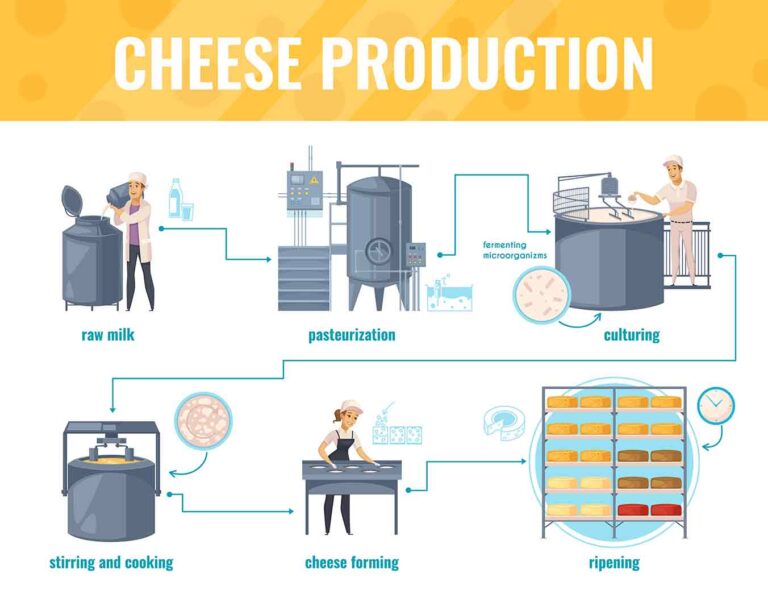- IELTS WRITING TASK 1 - PROCESS DIAGRAM
CHEESE PRODUCTION PROCESS
You should spend about 20 minutes on this task.
Task: The diagram illustrates the process of cheese production, beginning with raw milk and concluding with the ripening of the cheese. Summarize the information by selecting and reporting the main features, and make comparisons where relevant.
Write at least 150 words.
Sample Answer, C1 English Level, Advanced, Band Score 6.5-7.5
The provided diagram depicts the stages involved in the process of cheese production, commencing with raw milk and culminating in the maturation of the cheese.
To initiate the process, raw milk is collected and undergoes pasteurization, a heat treatment aimed at eradicating harmful microorganisms and enzymes. Subsequently, the pasteurized milk is subjected to the introduction of fermenting microorganisms for culturing. This step is vital as it initiates the fermentation process, which contributes to the development of flavor and texture within the cheese.
Following culturing, the milk is mixed and heated, causing the formation of curds. The curds are then separated from the liquid whey and subsequently compressed to achieve the desired shape of the cheese. The specifics of this stage may differ based on the type of cheese being produced.
Upon reaching the cheese-forming stage, the product enters the ripening phase. During this period, chemical reactions take place within the cheese, leading to the refinement of its taste, aroma, and consistency. The duration of the ripening process varies significantly, contingent on the type of cheese being created.
In conclusion, the process of cheese production encompasses pasteurization, culturing with fermenting microorganisms, curd formation, and eventual ripening. These steps collectively contribute to the distinctive characteristics of different cheese varieties.
The picture shows how cheese is made, starting with raw milk and ending with the matured cheese. The process involves several steps.
First, the raw milk is heated to kill any harmful germs through pasteurization. Then, special germs are added to the milk, which helps give cheese its taste and texture. This is called culturing.
Next, the milk is stirred and heated again. This causes the milk to thicken and form lumps, which are known as curds. The curds are separated from the liquid part, which is called whey. The curds are then pressed into molds to shape the cheese.
After shaping, the cheese goes through a period of ripening. During this time, the cheese changes chemically, which affects its flavor, smell, and how it feels in the mouth. The ripening time can be different depending on what kind of cheese is being made.
To sum up, cheese production includes heating milk, adding special germs for culturing, creating curds by heating and stirring, shaping the cheese, and finally letting it mature. These steps all work together to make different types of cheese with their own unique tastes and textures.
The diagram elucidates the intricate process of cheese fabrication, tracing its course from raw milk to the eventual attainment of mature cheese. The procedure unfolds through a sequence of well-defined stages, each contributing to the distinctive attributes of the final product.
The process commences with pasteurization, wherein raw milk is subjected to heat to neutralize any potential pathogens. Following this, the introduction of fermenting microorganisms occurs, known as culturing, a pivotal phase that primes the milk for fermentation, thereby infusing the cheese with its characteristic flavor profile and texture.
The subsequent stages involve a meticulous interplay of mechanical and thermal processes. Stirring and heating lead to the formation of curds, which are subsequently segregated from the liquid whey. These curds are meticulously molded to confer the desired shape upon the cheese. The transformation then culminates in the ripening phase, a period characterized by intricate chemical reactions. These reactions orchestrate the final metamorphosis of taste, aroma, and consistency, culminating in the diverse spectrum of cheese varieties.
In essence, the cheese production process, encompassing pasteurization, culturing, curd creation, and ripening, represents an intricate fusion of science and artistry. The final result is an array of cheeses, each a testament to the careful orchestration of these multifaceted processes.


